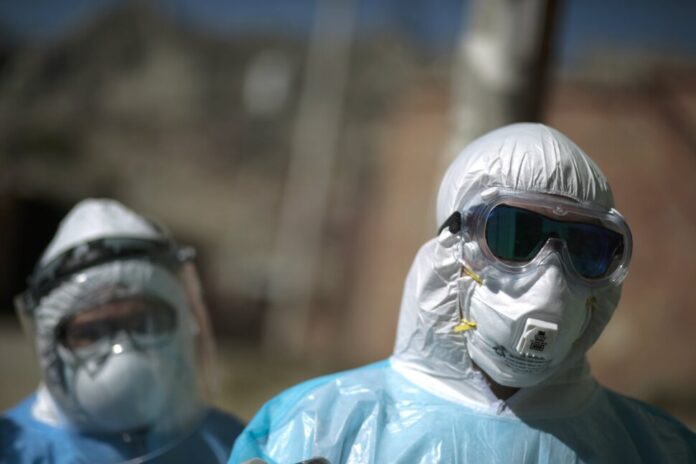Washington Watch
When news of Covid-19’s Omicron variant broke a few weeks back, my daughter sighed and said, “I give up. Just when I think we’ve turned a corner, we’re back in it all over again. I guess we have to be resigned to the fact that this will never end.” She expressed the dread felt by many that if this variant does, in fact, result in a fifth wave of the virus, it may be the one that finally breaks our spirit.
For the past 21 months, since the first covid-19 lockdown, we’ve been through a number of ups and downs. Each time we got our hopes up that the pandemic was receding, we became deflated when it came roaring back. I recall how we believed that the first lockdown in March 2020 would last only a month or so, after which we assumed that life would return to “normal.” Many of us did as we were told by the Centers for Disease Control and Prevention. We quarantined, avoided crowds, wore masks, and socially distanced. The problem was that too many of our fellow citizens didn’t take any of these precautions. Some were just lazy or, pardon me for saying so, dumb, and couldn’t understand the gravity of the menace we were facing. Worse still, many were influenced by then-President Donald Trump, who fearing the impact that pandemic precautions would have on the economy and his presidency, downplayed the danger and scoffed at the impact of the disease despite the advice of his own covid-19 Task Force.
As Trump assaulted those in the medical community who advised caution or the government officials who instituted precautionary lockdowns, he spawned a culture of conspiracy theorists who grew his rejection into an expansive and angry belief system. In their minds, the dangers of the pandemic were a fiction, the lockdowns a conspiracy that posed an existential threat to our freedoms, and the vaccines (that Trump had once boasted that he had helped to create) more dangerous than the disease they were supposed to cure.
By the winter of 2020-21, cases surged again and the hoped-for “return to normal” was delayed. This time, the sharpest rise in Covid-19 cases weren’t in the cities and states run by Democrats— as Trump had once cynically observed— they were in the very Republican states whose leadership had rejected lockdowns and precautionary measures.
Beginning in January 2021, vaccines were being rolled out for most Americans. Once again, many of us listened to the recommendations of CDC and received our first and second shots. And once again, too many of our fellow citizens didn’t. In some cases, it may have been due to lack of access or a historical distrust of the medical community. But all too often, the failure to get the vaccine had become a political statement of resistance. Overall, only 60 percent of eligible Americans have been vaccinated (a percentage lower than Vietnam, Cuba, and Cambodia). And nine of the top 10 states (with vaccination rates over 65 percent) are headed by Democrats, while the bottom 10 states (with vaccine rates under 50 percent) are all headed by Republicans.
After the first wave of vaccines, there was a downturn in reported cases and once again we let down our guard. Some states and cities prematurely ended their requirements on indoor masking and social distancing, and people began acting as if “we were back to normal.” It is in this context, that reports of yet a new and potentially more contagious covid-19 variant is such a cause for despair.
An honest look at where we are leads me to conclude that the hoped-for return to normal is, at best, wishful thinking. After 21 months of covid-19, it appears more likely that we will find ourselves in a “new normal” because so much has already changed that life will not easily revert to its pre-pandemic state.
Many government agencies and large corporate entities have continued to permit staff to work remotely— with many choosing not to return to their offices. Many lower-paid service workers, after initially being laid off, have joined the “gig economy.” They are earning more and enjoying the freedom and flexibility it provides. As their former workplaces have reopened, employers, finding it difficult to find replacement staff, have been forced to increase wages. In major cities, office spaces are empty and some businesses that serviced them have closed. To accommodate customers concerned with disease, restaurants have expanded outdoor seating and cut off street parking. Public transit has scaled back due to reductions in ridership. As a result, the face of city centres has changed.
But the most serious changes aren’t physical, they are political and psychological. In our new normal, we have become a dangerously divided polity in which we not only disagree on such fundamental issues as race and gender equality, but also have now politicized and become deeply divided over the health of ourselves, our children, and our communities.
School board and city council meetings have erupted in shouting matches over proposed mask and vaccine mandates. And some public officials who have imposed them have received death threats. It’s particularly worrisome that the angry debates on these matters of life and death aren’t even rational. Covid-19 infection rates among the unvaccinated are five times greater than those among the vaccinated, while the hospitalization and death rates are 10 times greater among the unvaccinated.
I fear that this deep and abiding division will carry over into a new normal. It will be a long time before some of us feel comfortable going maskless, and we will eye with suspicion and some fear or resentment those who refuse to mask or keep their distance. The maskless, in turn, will see those in masks not as individuals concerned with the health of themselves and their families, but as haughty liberals making a political statement.
This is where I fear we are. Our cities are changing, our workplaces are as well. We have become so deeply and angrily divided that even deadly disease has become partisan. Even if this new Omicron variant or the ones that follow are contained, I think it best that we shed the illusion that we will awaken one morning to find the pandemic over and life returned to the way it was. The normal that was is no longer. The covid-19 pandemic is transforming the lives of this generation the way the Great Depression, the World Wars, and the Cold War shaped the lives of our grandparents and parents. They adapted and survived. And I still have hope that we will too.






















